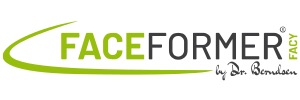Is there any research on FaceFormer® and cervical spine Eagle syndrome?
Question
Can you tell me if there is also research regarding cervical spine Eagle syndrome.
Answer
In cervical spine Eagle syndrome, the styli of the temporal bone are longer than average. They are connected to the hyoid bone via ligaments. Whether the lengthening of the bony elements actually plays a role must be considered very critically. As a rule, it is rather the head balance or the habitual straightening of the head that is of great importance. This is the only way to achieve the correct tension in the head-holding and head-balancing muscles. If the head posture is correct and stable, the elongated bone parts should no longer play a major role. In this respect, I would strongly advise consistent FaceFormer training. You can use it to train the correct head balance, in which movements and postures in the mouth and throat area also play an important role.
Through frequent repetition of the same exercises, these processes form patterns in the brain that become automatic. This state must be achieved so that you can constantly realise the stability of the posture without thinking about it. There are sufficient scientific studies on FaceFormer therapy, but they will only be related to specific symptoms. However, the priority correction of the actual complex of causes can have an effect on very many disorders.
There are innumerable syndromes and diseases and it is impossible to carry out a scientific investigation on every phenomenon. Cervical spine Eagle syndrome only considers the form deviation in the cervical spine area. On the other hand, we primarily consider the correction of muscular influences as an important prerequisite for solving the problem.
